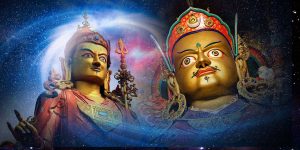Buddhist Pilgrimage: Purpose and Practice: deepening one’s connection, devotion and commitment to the Dharma
Dr. Miles Neale, a Buddhist psychotherapist — and founder of the Contemplative Studies Program — explains the profound practice, karmic and psychological benefits of formal pilgrimage to the sacred sites of Buddhism. A not-to-be missed special feature from a leading advocate for the integration of mind sciences, the practices of Buddhism and contemplative psychotherapy.
Pilgrimage changed my life, and in the last twenty years since my first adventure to the holy sites of the Buddha in Northern India when I was just twenty years old, I’ve had the fortune to embark on five other excursions. Now I lead pilgrimages to sacred sites all over Buddhist Asia, from India to Nepal, Sri Lanka to Java. In preparing for these journeys, I want to explore the purpose and practice of pilgrimage from a Buddhist point of view.
By Dr. Miles Neale
There are many reasons for travel these days: business travel facilitates networking opportunities and the conducting of commercial transactions. A vacation affords much-needed rest and relaxation and the chance to indulge the senses. Sightseeing tours offer onlookers a convenient means to observe ancient, historical or cultural landmarks, maximizing exposure in short duration. But pilgrimage is a unique reason for travel that is distinct in its motivation and execution.
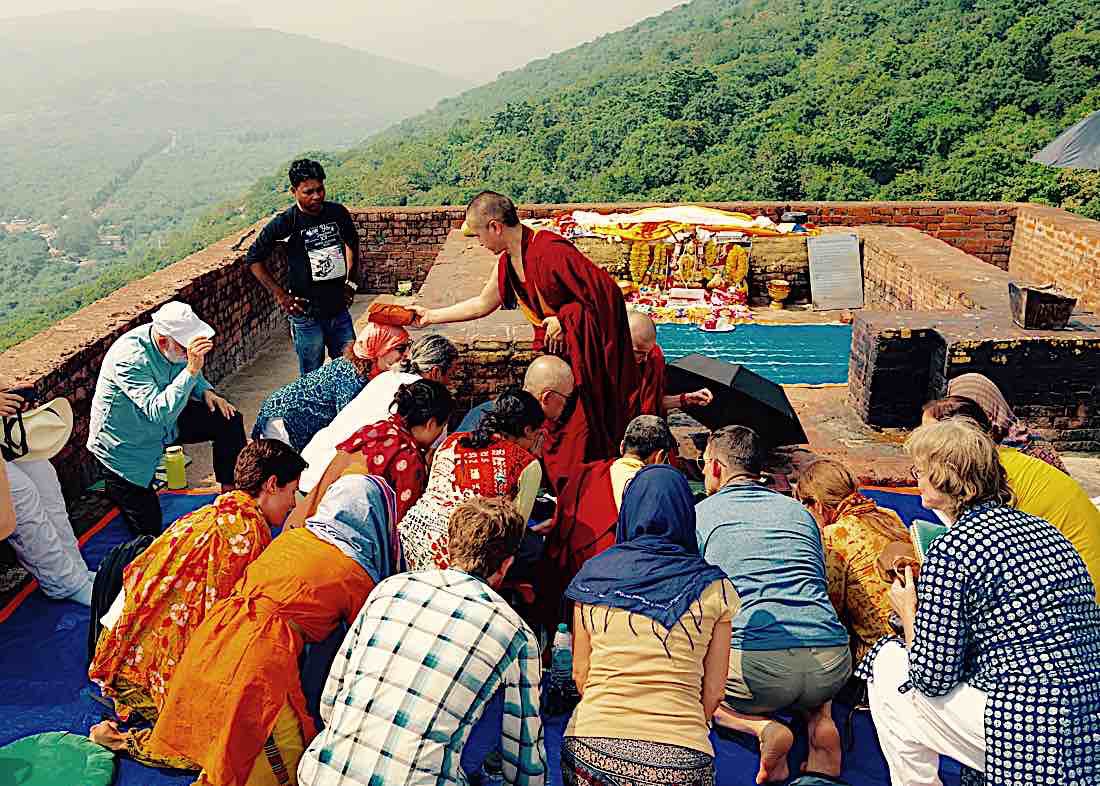
Pilgrimage is loosely defined as an outward journey of a religious or spiritual nature typically to shrine, temple, site or rite of significance to those of a particular faith or belief system. There are pilgrimages associated with all the worlds faiths and spiritual traditions, perhaps best known is the Hajj, a journey to Mecca considered one of the five pillars of Islam, and a mandatory act for any pious Muslim. Another famous pilgrimage is the Comino de Santiago, a journey made by Christians to the shrine that houses the remains of the apostle Saint James the Great in Galicia in northwestern Spain. Jews make pilgrimage to the Temple Mount in Jerusalem, while Tibetan Buddhist, Hindus and Jains circumambulate Mount Kailas (or Kailash) in the Himalayas. Rotating every four years Hindus in India gather at one of four sites along the Ganges river in what is known as the Kumbh Mela, considered the single largest gathering of human beings in one place on the planet.
What motivates someone to venture on pilgrimage and how they act while en route differs according to their worldview and practice. Here I’d like to focus exclusively on the Buddhist perspective.

Earliest Reference of Pilgrimage
The earliest reference of pilgrimage in Buddhism came from the Buddha himself in his last discourse before passing away and preserved in the Mahaparinirvana Sutra. His chief attendant Ananda expressed concern that the community would find it a challenge to maintain their faith and urgency without the Buddha’s presence. Thus the Buddha advised them to visit four specific places associated with him, to continue to practice as earnestly as if he was still living among them.
One way of understanding the power of pilgrimage is through the psychological process of association – the way human beings attribute meaning and significance to places and things. That power and meaning is maintained in the heart and minds of the devout, is transferred transgenerationally through narrative and remains alive through acts of commemoration.
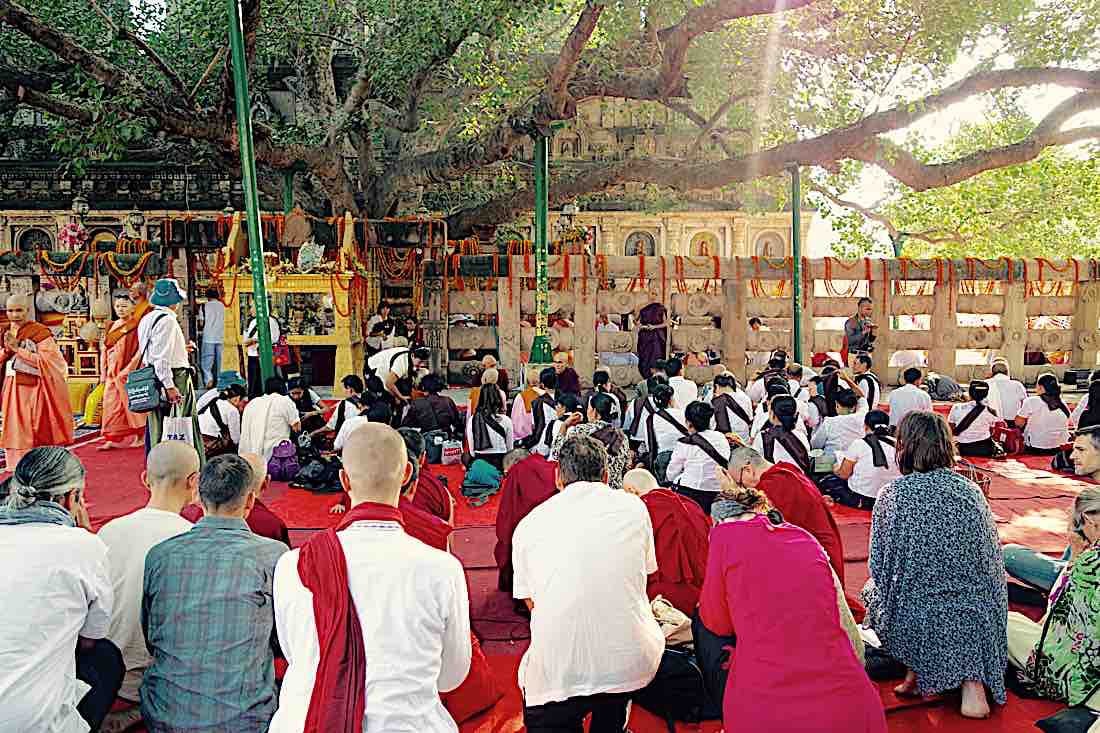
The Buddha’s birth, awakening, teachings and passing each occurred at geographically identifiable places and these sites have come to represent his living legacy and presence whereby successive generations of Buddhist pilgrims may continue to access the Buddha’s inspiration to transform their own way of being. In some cases, the Buddha’s actual remains were housed in shrines (stupas) at some of these sites making them living reliquaries that exude an even greater magnetism to those with devotion.
Sites of Buddhist Pilgrimage
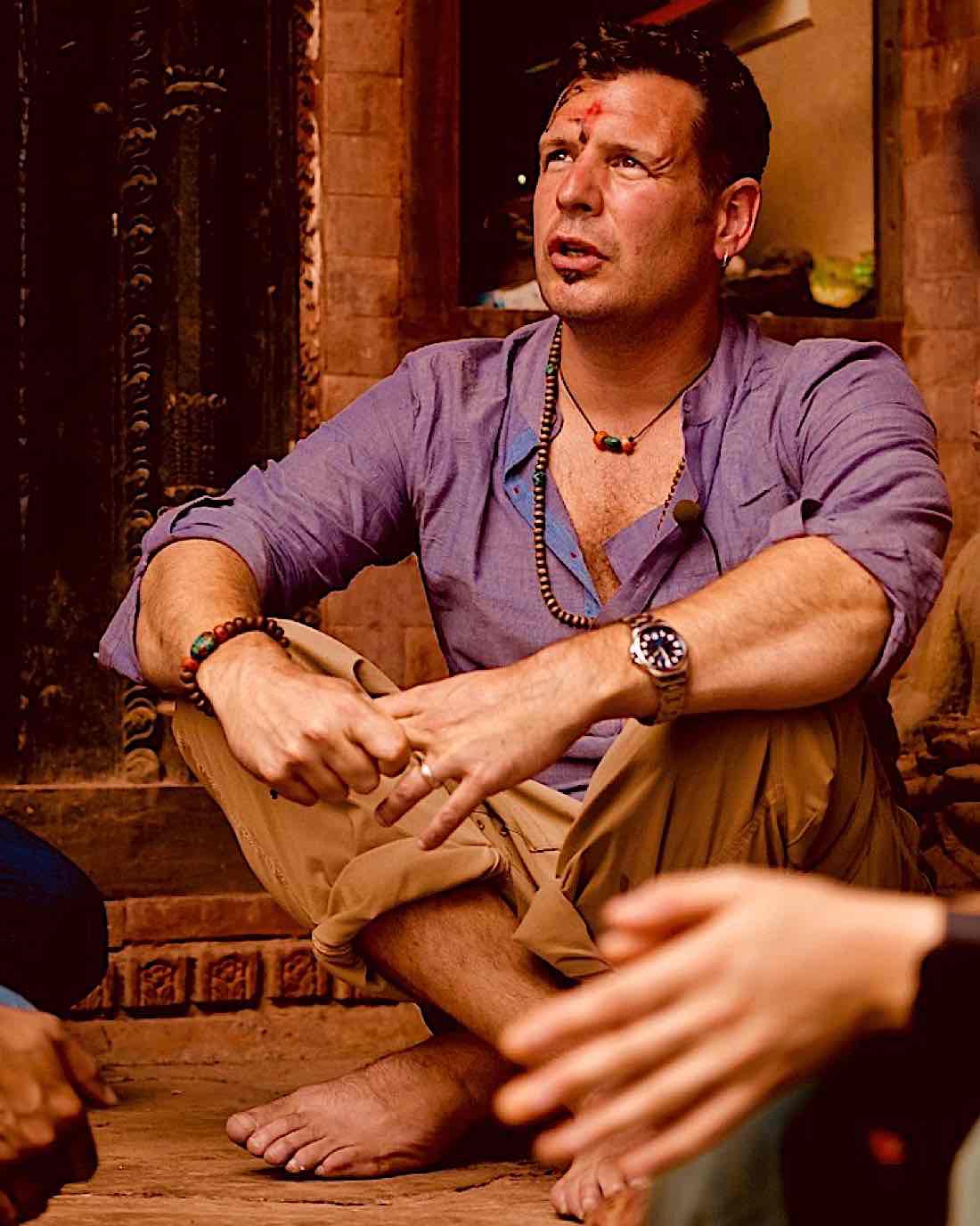
The four pilgrimages places the Buddha recommended are Lumbini (now in Nepal) where he was born, Bodhgaya the site of his awakening, Isipatana (now called Sarnath) where he turned the wheel of the Dharma in his first sermon on the Four Noble Truths, and Kusinara (now Kushinagar) where he passed into final release (Parinirvana). Later four more sacred sites were added as pilgrimage destinations because the Buddha is said to have performed great miracles there. The modern names of these additional sites are Sravasti, Vaishali, Sankasia, and Rajgir.
Along the Gangetic plains of Northern India where the Buddha lived and taught for nearly forty years, there are a number of other famous sites that continue to serve as destinations for pilgrims including Varanasi (Benares), considered the most sacred Hindu pilgrimage site in all of India and perhaps the longest, continually inhabited city in human history. The first great Buddhist universities and seats of contemplative learning including Nalanda, Vikramashila, and Odantapura, which for centuries attracted scholars and pilgrims of diverse faiths and traditions from as far as the Himalayas, Java and China, continue to this day to be places of veneration despite laying in ruin. Vulture Peak in Rajgir, where the Buddha revealed the nondual teachings of emptiness is also a popular pilgrimage site, particularly for East Asian Buddhist — who regard it as a power spot for the original mind-to-mind transmission of Chan and Zen lineages of Buddhism. The Dungeshwari Cave Temples, also known as Mahakala caves, on the outskirts of Bodhgaya — where the renunciate and former prince Siddhartha practiced extreme austerities and finally realized the middle-way prior to his enlightenment — continues to attract pilgrims who come to meditate in the caves and report it to be a place of tremendous energetic resonance.
In addition to these sacred sites in Northern India, over the centuries pilgrimage destinations have cropped up all over Buddhist Asia. For example in Sri Lanka, it is reported that the Buddha visited the sacred island on three separate occasions, and after his passing some of his remains were enshrined in various stupas drawing pilgrims from as far away as Thailand, Myanmar and China. In other cases such as the town of Pharping outside the Kathmandu Valley in Nepal, the sites are associated with great masters like Padmasambhava who is said to have achieved enlightenment while meditating in a cave.
Now pilgrims make immense efforts to reach these sites and sit in the very place where a succession of masters after the Buddha achieved their awakening.
Moreover, there are the iconic structures like Borobudur mandala in Java, Angkor Wat in Cambodia, the Tigers Nest in Bhutan and the temple ruins of Bagan in Myanmar that have served throughout the centuries as great epicentres of learning, practice and ritual, and veneration, which still attract the pious pilgrim today.
Purpose and Practice of Pilgrimage
So what is the purpose of pilgrimage and how is it practiced? The journey to sacred sites is a living act of taking refuge in the Three Jewels – a way of directly accessing and deepening one’s connection, devotion and commitment to the Buddha, his teachings (Dharma) and the community aspiring for awakening (Sangha). At least four psychological benefits can be attributed to the practice of pilgrimage: 1) Connecting with the inspiration and legacy of the Buddha and the possibility of one’s own awakening, 2) Purifying karmic imprints, 3) Cultivating merit or virtues, and 4) Establishing living networks with others pilgrims.
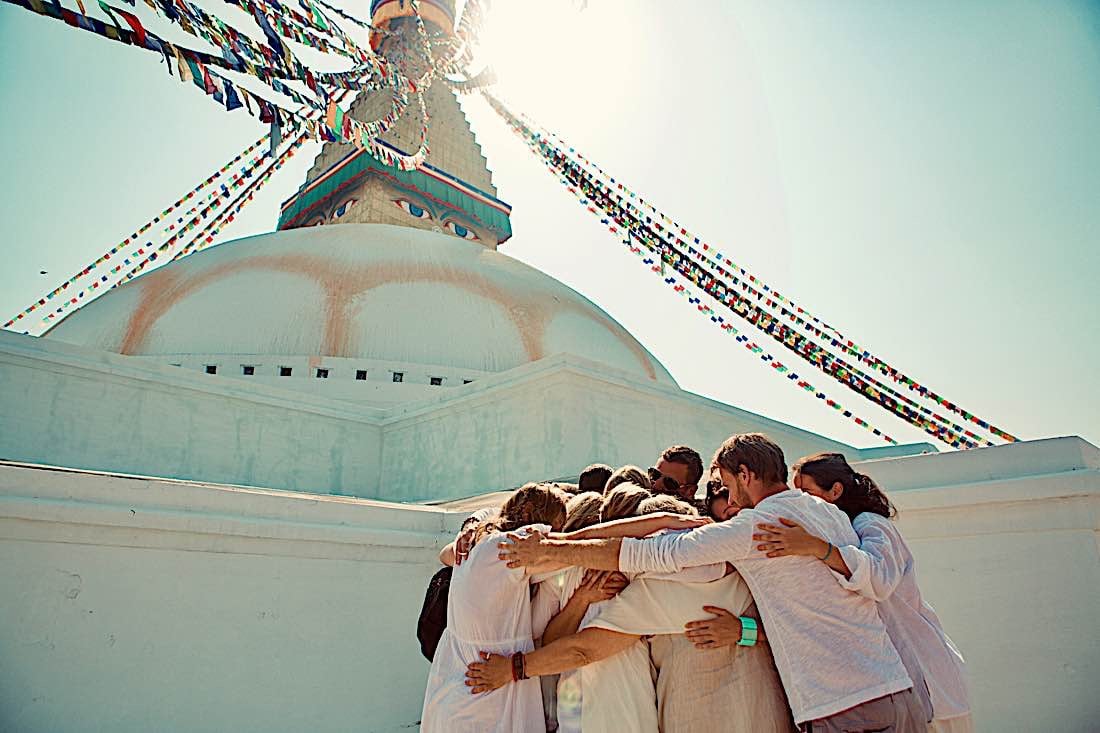
Connecting with the Buddha
So we can say that one purpose for pilgrimage in the Buddhist context is to directly connect with the living legacy of the Buddha in order to deepen one’s own insight into the nature of reality. Since the Buddha is not a god and has no special power to offer salvation, a pilgrimage is not considered a religious duty, moral act of penance or even a special offering in exchange for atonement, as might be understood in monotheistic traditions. Pilgrimage is a meditative practice (sadhana) in itself, one among many in the Buddhist toolkit, to achieve one’s spiritual goal of purifying the mind and awakening for the benefit of others.
During Buddhist pilgrimage, specific power places act like portals to allow us to connect, activate and embody altered states of consciousness and gain existential insights. When you sit near the Diamond Throne (vajrasana) under the Bodhi tree where the first human to gain enlightenment reportedly sat, you connect to the possibility that all of us have to achieve complete awakening. Anyone who ventures to Bodhgaya shares that vision of possibility — and so collectively pilgrims of all Buddhist cultures and traditions psychically invest and collectively tap an energetic charge that forms a resonance circuitry at that site. It is palpable by most upon arrival at the Mahabodhi Stupa in Bodhgaya but equally experienced at places such as the Boudanath Stupa in Kathmandu or the Ruwanweliseya Stupa in Sri Lanka.
Purifying Karmic Imprints
Dharma practice can be reduced to purifying negative karmic propensities that obscure the mind’s natural clarity while cultivating merits and innate positive qualities that allow the mind to flourish and inspire others. “Pilgrimage as practice” is a perspective I hope my students and I adopt to help us reframe the hardship we may encounter, to help us manage our expectations, to help us reprioritize our time and energies and to help us transform our activities into meaningful gestures of devotion, contemplation and transformation.
For over two thousand years, pilgrims have volunteered to endure a great deal of hardship to reach the holy sites of the Buddha. The time, energy, cost and resources required to make such a journey have always been enormous. Written accounts of Chinese pilgrims such as Fa Hsien and Hsuan Tsang from as early as the fourth century CE of their travels to Bodhgaya reveal that it took several years to get to India by foot, where they encountered illnesses, bandits, and near starvation, and witnessed many others die along the way. They report that this immense struggle was endured with great devotion because they saw pilgrimage as a part of their spiritual practice of cultivating their minds and not just a means of travel to a destination point.
Should it be any different in modern times? Though we now have commercial airlines, travel agents and advanced technology to ease the journey, pilgrimage by nature requires a massive investment of material and psychic resources and forces the pilgrim to confront all their self-imposed limitations, attachment to comforts, unrealistic expectations and naive fantasies about a spiritual journey.
From the outset a pilgrimage is not a vacation nor a sightseeing tour, thus the transportation, accommodation, destinations and way one comports oneself along the rout are all selected and carried out with specific altruistic intention, and as much as possible free of automaticity, greed, hatred and delusion.
For example, one’s accommodation should be safe and comfortable enough, but not so luxurious that it becomes the source of further craving, preoccupation or distraction. In other words, modest guest houses allow pilgrims to focus on why they are there, always connecting with their spiritual motivation and practice rather than getting sidetracked with the pleasantries offered by more sumptuous living arrangements.
But despite finding the delicate balance between external comfort and internal discipline, and once all the flights, guesthouses and itinerary have been mindfully determined; much psychological tumult and karmic reactivity are bound to be activated prior to, during and after pilgrimage.
Travel in India and other Buddhist countries throughout Asia is notoriously challenging and provoking for foreigners. The distance from Western countries where my groups embark from, and the extreme poverty, sensory overload, disorganization, and sheer volume of people that India, Nepal, China and other countries maintain, can push even the most well-prepared individual to their edge and beyond.
Then there is the group dynamic itself to consider. Spending time in tight quarters, on long travel routes, in third world conditions, exhausted by time differences and exposure to diseases, and where all the members of the group are well outside of their comforts zone, can seem like a recipe for disaster. So when the proverbial “shit hits the fan”, the perspective and practice of the pilgrim is key to ensuring that adversity may be transformed to advantage.
In a spiritual context – whether in a static community center or on pilgrimage – its not that conflict amongst members should be avoided, it is that there should be enough safety, trust and understanding to express, process and negotiate real human feelings and needs. In other words, interactions don’t have to be perfect, rather humanness, flaws, and conflict become training opportunities for empathy, clear communication and mutual understanding.
Long flights, poor food, illness, missing one’s family, being accosted by locals, and getting lost, are all conditions for karmic ripening.
Before we leave, group members are prepped to endure such difficulties as acts of purification, burning up the residue of self-preoccupation, envy, pride, hostility in the crucible of their unpleasant experience. More specifically, it is the convergence of attentional presence, humble surrender, loving acceptance and intuitive understanding that allows unpleasant ripenings to be activated and exhausted in consciousness, without further aggravation or causal reactivity. To say that part of pilgrimage is to “feel the burn” or “purge karma” would be a hard sell to prospective pilgrims, but that is closer to the truth and the required attitude to adopt.
Cultivating Virtue
While we purify negativities, by allowing ourselves to experience hardship with mindful acceptance, we are also committed to cultivating positive qualities by planting new seeds for our future unfoldment through intentional acts of generosity, compassion, patience, and understanding. There are many ways to cultivate virtue, both informal formal. Obviously, informal acts are spontaneous acts of human goodwill with group members, locals in the community, those who help to facilitate the pilgrimage and visiting pilgrims from other nations. Even when language, nationality, economic status, and religious differences exist, there is always a shared humanity and common interest that can be prioritized, honored and used as a springboard for exchanging the milk of human kindness.
As for the formal practices and procedures for cultivating virtues and merits, the list is as numerous as the pilgrims themselves. One thing to consider and respect about India is its unparalleled open-mindedness and tolerance of religious diversity. The Indian philosophical notion of ishvara pranidhana, literally “deity of one’s choice,” offers the spiritual practitioner a wide range of divine forms to supplicate as well as complete liberty in the mode and manner in which one may express their devotion.
One needs not look further than Hindus praying in the morning in Varanasi on the steps leading to the Ganges river. Each person prays to their own personal notion of God, in their own personal way, yet together, side-by-side, and without conflict or contradistinction. Likewise, on Buddhist pilgrimage, the way one wishes to expresses their devotion, gratitude, and inspiration is a personal one with wide margins of possibility. The only caveat to this is cultural-specific expectations such as never pointing one’s feet toward a religious icon, or wearing revealing clothes (mid-drift, shoulders of legs particularly for women) at a sacred site or temple.
Practice of Generosity
Acts of generosity, which cultivate the future subjective experience of abundance include offerings of light (candles), aromatic incense, flowers, fruits, sweets and money. These can be made at the holy sites, toward statues, shrines, and monks, and even the local community surrounding sites.
When offerings are made at holy sites, it is said the karmic effect is multiplied. This may sound like superstition unless it is viewed through the lens of the neuroscience of association.
The magnitude and significance attributed to a sacred space naturally heightens consciousness, concentrates awareness and produces positive emotions all of which deepen neural wiring to the act of generosity, consolidate the memory for later retrieval and seal in the virtue. Think about how easy it is to remember a wedding or graduation decades after the event because the memory was stored under the influence of focal attention and positive emotions like love and joy. Performing acts of kindness and generosity at holy sites leaves an indelible mark on memory and consciousness and allows positive neural networks to displace stores of scarcity and alienation.
Vow taking and maintaining
Taking and maintaining vows while at sacred sites is also said to magnify the karmic results due to the power of association. Often at holy sites, one stays at a guest house (vihara) where pilgrims are expected to maintain five lay vows of avoiding killing, stealing, lying, sexual inappropriateness and intoxication. Keeping these vows intact deepens their result while breaking them creates an adverse impression on memory.
One can assume additional vows of chastity and moderation know as the Mahayana precepts [Link downloads a PDF from FPMT] of avoiding luxurious accommodations, eating only one meal a day before noon, avoiding intoxifying singing, dance, or music that imbalances the senses, as well as perfumes, jewelry, makeup and ornamentation that can also lead to excess sense distraction, pride, envy and jealousy. There is nothing more significant than the opportunity to take and keep at a holy site the formal refuge vows – a commitment to becoming a Buddhist on the path to liberation – and the Boddhisttava vow, the altruist resolve to pursue liberation for others – in a ceremony with a reliable Mahayana guide. A reminder of the karmic consequences of the ten positive actions are:
1. Non-violence leads to peace
2. Generosity leads to abundance
3. Sexual sublimation leads to satisfaction
4. Honesty engenders trust
5. Tactful speech engenders respect
6. Caring speech engenders leadership
7. Meaningful speech engenders authority
8. Philanthropic intent results in contentment
9. Benevolent intent results in confidence
10. Realistic views result in clarity
Spiritual practice (Sadhana)
Practicing one’s personal prayers, liturgy, and meditation commitments at the holy sites are said to hasten the accomplishment of one’s goal. The reciting of texts and prayers is particularly those specifically associated with sites is considered highly meritorious. This includes the Setting in Motion the Wheel of the Dharma recited at Sarnath, Hearth Sutra recited at Vulture peak, or the beloved Loving Kindness (Metta) Sutta chanted at stupas dotting the island of Sri Lanka and so on. Many of the Tibetans who visit Bodhgaya attempt to complete their ngondro – a set of preliminary practices that are comprised of 100,000 repetitions each of prostrations to purify pride, altruistic intentions to purify jealousy, mandala offerings to purify greed, Vajrasattva mantras to purify aggression, and guru-supplications to purify misperceptions. Even doing a set of 108 or 1000 Vajrasattva purification mantras, or Confession of Buddhas practice at a holy site is of incredible significance.
Community
Ariel images of a sea of millions of devout Muslims at the Hajj, all dressed in white, conveys the sense of commonality that pilgrimage can inspire. When differences that normally define and separate us during ordinary life affairs are cast off, then a common bond with others can be forged that reminds of us of our true nature: interconnected. People on pilgrimage come to the Buddhist sites of India from various countries around the world, speaking numerous languages, and represent a multiplicity of lineages and traditions within Buddhism, but all with sincerity in their hearts and the wish to be free for the benefit of all. This is a fruitful time of mutually enriching exchange when Americans and Europeans can share ideas and customs with Tibetans, Vietnamese with Bhutanese, Sri Lankans with the Chinese. Beyond learning from differences, commonality and shared humanity can be accessed. Pilgrims can relate to one another as Dharma brothers and sisters, born in a new spiritual family, taking the Buddhas as the prototype of a new way of being and encouraging one another to live up to that ideal. When so much hatred, violence, greed and prejudice exists in the world, a pilgrimage is not only a great unifier but a direct antidote to fundamental instincts that assails us and creates so much destruction.
For many, a pilgrimage to the sacred sites of Buddhist Asia will happen but once in a lifetime. Not only does one venture to a physical destination of incredible historical significance but one experiences rite-of-passage that has tremendous power for psychological development.
For most, pilgrimage is a meditation in motion, designed for us to connect with the ideal of awakening through the living legacy of the Buddha and heirs. Along the way, we will naturally encounter hardship that can be used to purify negativities, and we will also accrue a vast amount of merits amplified by the energetic potency of the sites themselves. In just a few weeks on the road one can collapse in time what famous mythologist Joseph Campbell called a heroic journey, serving as a catalyst for all the essential metaphoric stages of human transformation from departure to initiation, from slaying one’s dragon to finding treasure and eventually returning home with elixir for the benefit of others. Finally, pilgrimage affords the precious opportunity to dissolve boundaries and distinctions between groups and cultures and tap our shared humanity. While there are as many pilgrims eager to embark, and many spectacular sites to visit, ultimately there is only one destination: the full flowering of the human heart and mind.
Bio photo credit: Phill Oleary
More articles by this author
Search
Latest Features
Please support the "Spread the Dharma" mission as one of our heroic Dharma Supporting Members, or with a one-time donation.
Please Help Support the “Spread the Dharma” Mission!

Be a part of the noble mission as a supporting member or a patron, or a volunteer contributor of content.
The power of Dharma to help sentient beings, in part, lies in ensuring access to Buddha’s precious Dharma — the mission of Buddha Weekly. We can’t do it without you!
A non-profit association since 2007, Buddha Weekly published many feature articles, videos, and, podcasts. Please consider supporting the mission to preserve and “Spread the Dharma." Your support as either a patron or a supporting member helps defray the high costs of producing quality Dharma content. Thank you! Learn more here, or become one of our super karma heroes on Patreon.
Doctor Miles Neale
Author | Buddha Weekly
Dr. Miles Neale, PsyD, is a Buddhist psychotherapist in private practice and founder of the two-year online Contemplative Studies Program. Author of Gradual Awakening (Sounds True, 2018) and co-editor of Advances in Contemplative Psychotherapy (Routledge, 2017), Miles is a faculty member of Tibet House (US) and Weill Cornell Medical College. With more than twenty years integrating the mind science and meditative practices of Tibetan Buddhism with psychotherapy, trauma research and neuroscience, Miles is a forerunner in the emerging field of contemplative psychotherapy, and leads pilgrimages around the Buddhist world.
Dr. Neale is the author of Gradual Awakening as well as Advances in Contemplative Psychology. His author page on Amazon is: https://www.amazon.com/author/milesneale
“Trauma-informed Dharma. That’s what I call the integration of Tibet’s ancient mind science with current breakthroughs in psychotherapy, trauma research and neuroscience, offering the most powerful synthesis for human transformation.”
— Dr. Miles Neale
Contemplative Studies Program website:
https://www.gradualpath.com/
Bio photo credit: Phill Oleary






